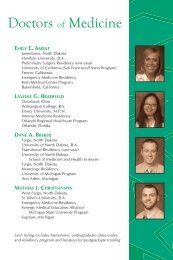Fall 2006 - North Dakota Medicine
Fall 2006 - North Dakota Medicine
Fall 2006 - North Dakota Medicine
- No tags were found...
Create successful ePaper yourself
Turn your PDF publications into a flip-book with our unique Google optimized e-Paper software.
Killing the KidneysThe most recent research ofEdward Carlson, Ph.D. 70, ChesterFritz Distinguished Professor and chairof the anatomy and cell biologydepartment at UND, looks at the longtermeffects of diabetes on the smallblood vessels of the kidney.Although these tiny blood vessels,or capillaries, are only a tenth thediameter of a human hair, they play animportant role of fencing protein in theblood stream. The capillary walls ofthe kidney include a tube-like structurecalled the basement membrane, whichworks as a filter allowing the blood tojettison things that are not needed andkeep what is. However, long-termhyperglycemia caused by diabetes canstart to make the basement membranerigid, brittle and more permeable,allowing protein to leave the capillary.This results in renal disease, or diseaseof the kidney.Diabetes is the leading cause ofend-stage renal disease, accounting for44 percent of new cases, according tothe CDC. In 2001, nearly 143,000people with end-stage renal disease dueto diabetes were living on chronicdialysis or with a kidney transplant.Carlson and his research partner,former UND pharmacology chair PaulEpstein, Ph.D., are looking at ways tocounteract the effect high blood sugarhas on the basement membrane ofkidney capillaries.We can estimate your age bylooking at your capillaries, explainsCarlson. Diabetes is sometimes calledthe disease of premature aging. Thecapillaries of a person with diabetes willlook much older than they actually are.Epstein, an animal geneticist who isnow professor of pediatrics at theUniversity of Louisville, has developedtwo types of mice for their work. Thefirst type of mouse is born withdiabetes. The second kind of mouse isalso diabetic, but it also creates moreantioxidants than a typical mouse.Significantly, in the diabetic mousethat creates more antioxidants thanusual, basement membranes areprotected against increasedpermeability and other characteristics ofadvanced diabetic kidney disease.Carlson and his students are examiningthe cells and basement membranes inthese genetically engineered mousemodels using the UND medicalschools electron microscope. Theyhave demonstrated several new findingsincluding changes in basementmembrane thickness as well as alteredcell shape and number.It seems that the excessantioxidants are eating away at the freeradicals that cause the filteringmechanism in the kidney to ageprematurely, explained Carlson.Carlson hopes that their work willinspire clinical trials in which peoplewith diabetes could be treated withantioxidants and, hopefully, have thesame results as these mice.We hope that it can be shown thatantioxidants successfully prevent thechronic complications of diabetes,he said.This is truly exciting work, saidCarlson. It is so much fun. I get upevery morning and I can hardly wait toget here to see what is happening now.-Amanda ScurryAntioxidants AttackCarlson and Epstein are studyingthe effects of antioxidants on thispremature aging of the capillaries,which causes them to become rigid andmore permeable much sooner than theyshould. This premature aging of thecapillaries is caused by an unusuallyhigh level of free radicals in the bodiesof people with diabetes.●●●●●CranberriesBlueberriesBlackberriesRed, black, pintoand kidney beansArtichoke heartsSources of Antioxidants●●●●●Russet andsweet potatoesSpinachEggplantApplesPeaches● Mangos● Melons● Green andblack teas● CoffeeSource: WebMD.comNORTH DAKOTA MEDICINE <strong>Fall</strong> <strong>2006</strong> 15
















